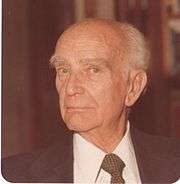Domingo Cirici Ventalló
Domingo Cirici Ventalló (1878–1917) was a Spanish novelist, editor and political militant. During his lifetime he gained wide popularity as author of 4 novels; currently classified as political fiction or dystopian prose, they are considered second-rate literature. His best known work La República española en 1.91... (1911) fairly accurately predicted the advent of the Republic, its sectarian politics, collapse of public order and the ensuing military coup. As a journalist Cirici contributed to some 30 Conservative and Catholic dailies, but is best known as editor-in-chief of El Correo Español and briefly the key author of El Debate. Politically Cirici remained a Carlist; he advanced the Traditionalist outlook both in his novels and in his press work, though he did not hold any post in the party and his attempts to obtain a seat in the Cortes ended in failure.
Domingo Cirici Ventalló | |
|---|---|
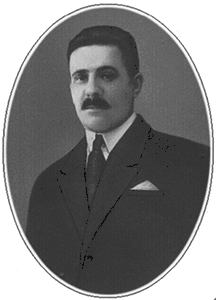 | |
| Born | Domingo Cirici Ventalló 1878 Terrassa, Spain |
| Died | 1917 Madrid, Spain |
| Nationality | Spanish |
| Known for | novelist, editor |
| Political party | Carlism |
Family and youth
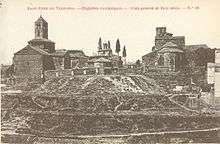
There is little known about paternal ascendants of Cirici Ventalló; the Cirici family has not been recorded until the 19th century, when some of its representatives were noted in Northern Catalonia. The father of Domingo, Matías Cirici Traver[1] (1837–1912),[2] originated from Seu d'urgell.[3] It is not clear what he was doing for a living; in later official documents he was recorded as "propietario".[4] In 1875[5] he married Vicenta Ventalló Vintró,[6] descendant to a prestigious local family. Her father and the maternal grandfather of Cirici Ventalló, Domingo Ventalló Llobateras (1805–1878), was a Terrassa pharmacist and served as alcalde of the town, the role performed at the turn of the centuries also by one of his sons.[7] Author of a few works on hydrology, Ventalló Llobateras was also the leader of local conservative Catholics.[8]
The newly wed Matías and Vicenta settled in Terrassa,[9] though either in the late 1880s or early 1890s they moved to Barcelona. They had 6 children, 3 daughters[10] and 3 sons.[11] Domingo was raised in a pious Catholic ambience and educated in Real Colegio Tarrasense, an establishment catering to local bourgeoisie.[12] None of the sources consulted indicates whether he entered a university or graduated; since his early teens he contributed to local periodicals and when in 1897 he settled on his own in Barcelona it was because he commenced professional career as a journalist.[13] Cirici Ventalló got married in 1900 at an unusually early age of 22.[14] The bride, María de la Concepción Babé Botana (1882–1971),[15] was even younger; almost nothing is known about her family or herself, except that she has outlived her husband by 54 years.
Domingo and Concepción settled in Barcelona. They had 5 children, born between 1903 and 1916: Matías,[16] Domingo, Carmen,[17] Ana[18] and Francisco;[19] Ana died at the age of 5 in 1921.[20] Matías Cirici Babé earned his name as a screenwriter contributing to Hollywood films of the 1930s and Spanish ones of the early 1940s; until the 1970s he worked for a popular weekly Ya, periodically heading its foreign section;[21] in both roles he appeared as "Matías Cirici-Ventalló".[22] Another son Domingo tried his hand as historian of Latin American literature; he signed as "Domingo Cirici Ventalló".[23] The granddaughter of Cirici Ventalló, Carmen Cirici-Ventalló Aguayo, earned her name in Mexico as music producer, painter, sculptor and translator, but also as wife of Eduardo Mata.[24] Among other relatives Domingo's brother-in-law, Andrés Babé Botana, was moderately popular as an actor, known as "Mellaíto".[25] Domingo's maternal uncles José Ventalló Vintró and Pedro Antonio Ventalló Vintró were acknowledged in the local Terrassa ambience, the former as a historian[26] and the latter as a poet, "Cantor d’Egara".[27] Two of his maternal step-cousins[28] became known in Catalan literature in politics. Joaquín Ventalló Vergés was a Catalan poet, translator and Esquerra Republicana politician,[29] while Lluis Ventalló Vergés was a Carlist militant and the first Francoist civil governor or the Lerida province.[30]
Periodista
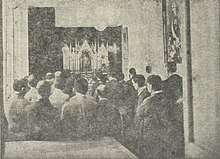
Inspired by literary endeavors of his uncles the young Domingo was also tempted by letters.[31] He commenced his career as teenager[32] by contributing to La Comarca del Vallès, issued by José Ventalló.[33] In 1897 he started co-operation with the Barcelona dailies Las Noticias and El Noticiero Universal.[34] His first signed contribution identified is an 1899 chronicle published in the Carlist Barcelona daily La Dinastía,[35] though the same year he contributed lyrical prose to a Liberal daily La Lucha.[36] Throughout the next few years Cirici worked also for Barcelona newspapers El Correo Catalan and La Veu,[37] for a weekly Mar y Tierra[38] and for provincial dailies Diario de Tortosa[39] and La Situación.[40] He published little under his own name; it is not clear whether he used pen-names. According to some sources he wrote also in Catalan,[41] yet no such contribution has been identified. He earned some recognition[42] and as representative of "Catalan press" he covered local meetings involving Spanish politicians;[43] he also entered the executive of Asociación de la Prensa de Barcelona.[44] Already recognized for vehemently right-wing views, in 1907 he was about to have a duel with his preferred bête noire, Alejandro Lerroux.[45]
At unspecified time between 1907 and 1909 Cirici moved to Madrid.[46] According to some sources, he was invited either by the veteran Carlist publisher Salvador Morales Marcén or by the Traditionalist ideologue Juan Vázquez de Mella, who offered him a job in the unofficial Carlist mouthpiece, El Correo Español.[47] In 1910 latest Cirici joined its staff[48] and specialized in coverage of parliamentarian debates; the section he invented and ran, Del Mentidero, mocked the deputies and became enormously popular among readers;[49] it was continued until 1914.[50] Apart from other editorial work Cirici worked as envoy covering major events, e.g. the legitimist coup in Portugal;[51] minor pieces were published with a pen-name "Cirvent".[52] Already in 1913 he was considered as a potential chief editor;[53] he assumed the job and became second-in-command in Correo in 1916,[54] when he also started to publish editorials.[55]

Apart from his Correo assignment in the 1910s Cirici contributed to many mostly provincial and usually Carlist, conservative or at least Catholic dailies, especially Diario de Valencia[56] and El Norte from Girona;[57] the others were La Independencia from Almería,[58] El Restaurador from Tortosa,[59] El Pueblo Manchego from Ciudad Real,[60] La Gaceta de Tenerife,[61] Heraldo Alaves,[62] El bien público from Mahón[63] and La Tradición from Tortosa; less frequently his writings appeared in at least 20 other titles[64] and in papers published in Latin America.[65] In 1912–1913 he also managed ephemerical satirical weeklies El Mentidero and El Fusil.[66] Already as a star of journalism starting 1917 Cirici signed an exclusive contract with El Debate[67] and almost ceased publishing elsewhere. Though still redactor-jefe of Correo,[68] he became the most recognized pen of Herrera Oria’s newspaper; apart from commentaries he worked as envoy[69] and interviewed key politicians, e.g. Antonio Maura.[70] Last but not least, Cirici became one of key persons behind the Madrid professional corporation, Prensa Asociada.[71]
Novelist
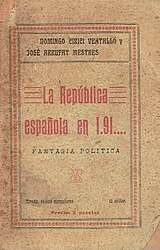
In 1911 Cirici and José Arrufat Mestres released La República española en 1.91...,[72] the novel next year followed – this time authored by Cirici only – by sort of a sequel, Memorias de Muñoz Villena.[73] Both books were political pamphlets aimed against the Left and featured Spain of the near future. The monarchy was toppled and replaced with a republic, ran by a republican-socialist coalition; it declared agrarian reform and official atheism, banning public Catholic cult; as growing chaos and separatism produced collapse of public order, a rebellious general staged a coup intended to save the country. The narratives featured numerous real life personalities, usually set in sinister roles of cynical political manipulators:[74] Lerroux, Alvarez, Galdós, Largo Caballero, Weyler, Iglesias, Romanones, Azcárate, Alcalá-Zamora, Besteiro and many others, though the rebel general was a fictitious person.[75] A few episodes might have seemed off-limits, e.g. Galdós as president of the republic was killed in an assassination attempt.[76]
Following commercial success of especially República Cirici adhered to the same genre of political fiction[77] when in 1914 he published El secreto de lord Kitchener.[78] Again a voice in heated public discourse, the novel formed part of ongoing propaganda war about the role of Spain in the unfolding European conflict. It advanced a vehemently pro-German and anti-British outlook; the novel was formatted as a series of rather loosely related stand-alone chapters, each telling its own story. The narrative followed the future course of the war and ended with total defeat of the Entente; France was overrun, Britain lost almost all its overseas possessions, Germany obtained sort of Gibraltar in Kent and became the unchallenged European might, federated with Belgium and Poland.[79] Among many real-life personalities, also the foreign ones, again Liberal and Republican Spanish politicians were portrayed as lousy, mischievous failures; Kitchener was killed by an outraged suffragette.[80] The novel was a success;[81] moreover, it was promptly translated into German and Swedish.[82]
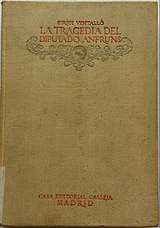
La tragedia del diputado Anfrúns[83] was first serialized in El Debate from January to May 1917, later that year released also as a book. Cirici remained within the limits of militant political fiction, though this time the plot was set not in the future but in the recent past. The novel focused on Catalonia; Cirici's venom was intended, apart from his usual liberal-republican enemies, also for the Catalanists, all indulging in corruption and caciquismo.[84] The novel tells the story of a young Liberal political hopeful. His cynicism and wit earn him first a place in the Barcelona ayuntamiento and then in the Cortes, let alone millions of a cleverly married girl from a Mexico-based indiano family. However, he is eventually outsmarted by equally cynical collaborators and malicious wife; Anfrúns dies when involved in half-legal war supplies to the French army. Like in Memorias the key protagonist was a fictitious character interfacing mostly with real-life personalities; apart from the customary black characters of Lerroux or Romanones,[85] this time they included many Catalans like Comas y Masferrer, Cambó and Planas y Casals.[86]
Carlist

Cirici Ventalló descended from the Carlist family and acquired the Traditionalist outlook from his paternal ancestors,[87] and perhaps also maternal relatives.[88] His press career is from the onset marked by militant Carlist zeal, demonstrated in the 1900s in periodicals like La Dinastía,[89] El Correo Catalan or La Veu.[90] He was soon noticed by party pundits and offered to join El Correo Español.[91] Cirici soon became one of the key contributors to the daily, pursuing the legitimist cause also in other party-related papers like El Norte;[92] La Independencia,[93] El Restaurador,[94] or La Tradición.[95] As the propagandist he soon grew to prominence and was privileged to run public conferences of the party leader, Bartolomé Feliú.[96] In 1910 he prepared a lengthy pamphlet hailing the new Carlist king, Don Jaime,[97] whom he met for the first time in person in 1911.[98] The following year he published La Peregrinación de la Lealtad and Biografía de don Jaime de Borbón, the former a set of essays organized around the Carlist rally in Lourdes and the latter the biography of the claimant. Finally, in 1916 he contributed to a massive bibliographic review of Carlist press.[99]
Cirici a few times unsuccessfully tried to launch a strictly political career. In 1910 he was reported to compete for seat in the Cortes on the Carlist ticket from Valderrobres in Aragón;[100] none of the sources consulted confirms that he indeed ran. In 1914 he did stand as a candidate from Vilademuls;[101] having gained 1749 votes (28% of the total) he decisively lost to a Liberal counter-candidate.[102] In 1916 Cirici renewed his bid, this time as a joint Carlist-Maurist contender from Les Borges; with 1667 votes (20%) he was defeated by Francesc Macía.[103] His candidacy, apparently enforced by the national party executive, caused a minor turmoil in the provincial Lerida jefatura, which objected to both a cuckoo candidate and to the alliance strategy.[104]
Cirici's political activity fell on a period marked by growing paralysis of Carlism, torn by conflict between Vazquéz de Mella and Don Jaime; it very much focused on control of El Correo Español. It is not entirely clear what was the option followed by Cirici. On the one hand, he was brought to the editorial board by de Mella. On the other hand, in 1913 Don Jaime favored him for the post of editor-in-chief against the candidacy of Miguel Peñaflor, advanced and eventually successfully secured by de Mella.[105] None of the sources consulted notes Cirici as involved in the power struggle within the party and in the mid-1910s Peñaflor and Cirici went together well.[106] Moreover, during the Great War Cirici sided with de Mella and assumed a decisively pro-German stand, definitely against the neutralist or pro-Entente leaning of Don Jaime.[107] In case of another thorny issue, the Catalan question, Cirici championed the anti-Catalanist cause and opposed Carlist participation in initiatives like Solidaridad Catalana; some dub him "the father of Catalan españolismo".[108] According to some authors, Cirici was gradually getting lukewarm about the Carlist cause.[109]
Reception and legacy
.jpg)
During his lifetime Cirici remained a controversial figure, especially as a journalist. He was hailed by Conservative press as informed and competent commentator, expert on behind-the-scenes parliamentarian deals and "the best journalist in Spain".[110] The Republican and Socialist authors criticized and derided him[111] as "campeón del cinismo";[112] his vehemence cost him a judicial investigation triggered by a French ambassador[113] and periodical suspension of El Debate,[114] he also became a point of reference for zealous germanophilia.[115] As a novelist he was acclaimed for style[116] and wit,[117] by some declared "una de las más legitimas glorias del humorismo mundial" and the one who introduced political satire to Spain;[118] however, it is difficult to tell opinion of informed literary critics from marketing.[119] Commercially his novels were a success; while the Episodios nacionales Galdós’ books usually sold in 4–5,000 copies,[120] also the usual run of a novel at the time,[121] República sold in 39,000 copies,[122] Memorias in 15,000 copies[123] and Secreto in 20,000 copies,[124] all advertised as "most successful in bookstores in recent times".[125] The German translation of Secreto sold in 40,000 copies.[126] Sales results would have made Cirici a rich man; however, pressed by daily needs he used to sell copyright to the editors.[127]
Cirici's premature death[128] was acknowledged by nationwide press. Many titles launched a charity campaign intended to help the widow and the orphans[129] and Alfonso XIII arranged for his oldest son to be admitted to the college free of charge.[130] In the 1920s he was noted in works on history of Spanish literature as the author of "novelas de satira política con gran conocimiento del asunto, donaire y originalidad";[131] in 1931, when the Republic was actually declared, some recollected his earlier fiction.[132] Today the favorable opinion held by scholars like Cejador y Frauca does not stand; most historians of literature ignore him[133] and he is relegated to footnotes in works dealing with specific genres. Currently Cirici's novels are usually classified as "ficción utópica",[134] "ficción especulativa",[135] polítical fiction,[136] "extrapolación española"[137] or dystopia,[138] at times praised as "still readable";[139] in all cases they are noted as second-rate literature. Some suggest he sort of commenced a trend, with Elias Cerdá emerging as his follower in cultivating the genre.[140]
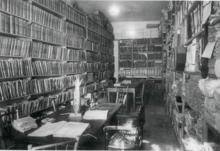
Within the Carlist realm Cirici was initially viewed as a potentially great literary herald of the cause; in 1916 he was honored with a dedicated homage session involving the party leader Marques de Cerralbo, the key theorist Vazquéz de Mella and others;[141] many party heavyweights attended his funeral, including de Cerralbo, de Mella[142] Conde de Doña Marina or Marqués de Tamarit.[143] However, he later went into almost total oblivion, except that some scholars claim a Traditionalist historian Melchor Ferrer Dalmau was influenced by Cirici's "españolismo catalan".[144] Rather exceptionally he featured in Carlist propaganda of the 1960s, listed among key party men of letters like Manuel Polo y Peyrolón or Luis Hernando de Larramendi.[145] Locally he is recognized as a noteworthy terrassenc in a biographical sympathetic article[146] and in a limited-circulation 2007 monographic book.[147]
Notes
- his exact segundo apellido is not clear. In two obituaries, probably published by his son, he is noted as "Traver", compare La Cruz 10.07.12, available here, and El Correo Espanol 09.07.12, available here. The biographer of Cirici Ventallo claims that the correct spelling is "Travé", Àngels Carles-Pomar, Domingo Cirici Ventalló: un periodista terrassenc a Madrid, Terrassa 2007, ISBN 9788493542405, p. 31. She also advances a catalanised version of his name, "Matias Cirici i Travé", which he was unlikely to use; if so, he would have used "Matías Cirici y Travé"
- his date of death is clear, see e.g. El Correo Espanol 09.07.12, available here. His date of birth is subject to doubt. A newspaper obituary claims he died "at the age of 77", which might point to 1835 though also 1834 or 1836, see La Cruz 10.07.12, available here. Cirici's biographer claims – possibly on basis of official documentation – that he was born in 1837, Carles-Pomar 2007, p. 31
- Carles-Pomar 2007, p. 31; some family members including his brother were also noted as related to Seu d’Urgell, see La Discusion 19.05.59, available here
- Carles-Pomar 2007, p. 31
- Carles-Pomar 2007, p. 31
- Domènec Ventalló Llobateras entry, [in:] MyHeritage service, available here
- José Ventalló Vintró served as alcalde of Terrassa in 1895-7 and 1900-1, Juan Duch, La literatura en Tarrasa, Tarrasa 1964, pp. 19–20
- Duch 1964, p. 7
- at calle San Isidro 55, Carles-Pomar 2007, p. 31
- Concepcion died in 1926, La Vanguardia 20.05.26, available here; she was also known as Asunción, La Vanguardia 12.05.26, available here. Zoila died in 1931, La Vanguardia 16.10.31, available here. Constancia died in 1982, La Vanguardia 01.04.82, available here
- apart from Domingo the other sons were Angel and José, Carles-Pomar 2007, p. 31
- Carles-Pomar 2007, p. 32. Possibly he was also related to Escuela Apostólica del Sagrado Corazón in Barcelona, La Dinastía 19.08.97, available here
- Augusto Uribe, El boom de la política ficción, [in:] BEM 68 (1999), available online here
- La Dinastía 16.09.00, available here
- ABC 17.01.71, available here
- born 1903, died 1980, Hoja Oficial de Lunes 31.03.80, available here
- Domingo was born in 1912, Carmen in 1913, Ventalló entry, [in:] Ancestry service, available here
- Ana was born in 1916, El Debate 12.03.21, available here
- it is not clear when Francisco was born, El Debate 09.12.17, available here
- El Debate 12.03.21, available here
- ABC 19.05.42, available here
- Matías Cirici-Ventalló entry, [in:] CervantesVirtual service, available here
- in the early 1950s he published few works on literature in Guatemala in Cuadernos hispanoamericanos, see e.g.WorldCat service, available here
- Maru Ruiz de Icaza, Carmen Cirici-Ventalló, [in:] El Universal 02.01.00, available here
- see e.g. Valentín Azcune, Biblioteca teatral, Madrid 2007, ISBN 9788400085483, p. 143
- Duch 1964, pp. 19–20
- Ventalló i Vintó, Pere Antoni entry, [in:] Endrets service, available here
- Cirici ventallo's maternal grandfather Domingo Ventalló Llobateras was married twice, first with Eulalia Vintró (who gave birth to the future mother of Cirici Ventallo) and then with Dolores Homs (who gave birth to the future father of Ventalló Vergés brothers), Pau Vinyes i Roig, Visca la República! Joaquím Ventalló, periodista, polític, poeta i traductor, Barcelona 2010, ISBN 9788493774035, p. 14
- Vinyes i Roig 2010, p. 14
- see e.g. Mariona Vigués i Julià, Lluís G. Ventalló i Vergés, (1903–1980). De la fidelitat a Sala al compromís amb el Règim, Terrasa 2005, ISBN 849328274X
- initially he tried his hand in poetry. As member of the Terrassa Ateneo, he presented his verses in an 1895 session and excused his inexperience, which led his biographer to assume that the event was his first public appearance, Carles-Pomar 2007, p. 32
- one author claims that Cirici launched his press career at the age of 14, which would point to the years of 1892–1893, see Uribe 1999, available here. Another author cites a Comarca note from 1895; it welcomes Cirici as the new member of the staff, Carles-Pomar 2007, p. 32
- Jose Ventalló Vintró was publishing also other local periodicals, but it is not known whether Cirici Ventalló contributed, see Vinyes i Roig 2010. Cirici's juvenile press contributions revolved around the topics of social issues, Cuban insurgency and Spanish–American War, and regeneracionismo, Àngels Carles-Pomar, Domingo Cirici Ventalló, escriptor i publicista, [in:] Ciutat. Revista cultural d'Amics de les Arts i Joventuts Musicals 10 (2000), pp. 28–29. The author considers the early career of Cirici "un cas celebrat de nepotisme", Carles-Pomar 2000, p. 25
- Carles-Pomar 2000, pp. 25, 29
- La Dinastía 24.10.99, available here
- La Lucha 15.11.99, available here
- La Epoca 09.12.17, available here
- Mar y Tierra 16.10.00, available here
- Diario de Tortosa 15.01.03, available here
- a daily from Sabadell, Carles-Pomar 2000, p. 25
- El Pueblo Manchego 31.10.14, available here
- according to some rather unjustly; when other correspondents went to great lengths covering local events, Cirici wrote his correspondence from a cafeteria. He was declared hijo adoptivo by Pont de Vilomara as recognition of his article for El Noticiero, which praised brave local people; the article was written without Cirici ever visiting the town, see Les memòries de Clovis Eimeric, [in:] Annals del periodisme catala 13 (1935), available here. The same fellow journalist also elsewhere claims that Cirici preferred lively language to accuracy, see Lluís Almerich, La mala vida del periodista, [in:] Annals del periodisme catala 15 (1935), p. 531, available here
- La Vanguardia 08.05.00, available here
- La Vanguardia 24.09.00, available here
- El País 10.02.17, available here, Uribe 1999
- Duch 1964, p. 27
- El Correo Español 10.12.17, available here
- La Tradición 15.12.17, available here
- El Defensor de Córdoba 21.10.12, available here
- El Correo Español 05.01.14, available here
- La Correspondencia de España 22.10.11, available here
- El Restaurador 06.07.11, available here
- El Correo Español 21.07.16, available here
- officially his position was "redactor jefé de El Correo Español", Diario de Valencia 13.01.18, available here. The title corresponded to editor-in-chief; the number one position was held by "director", e.g. the manager
- El Correo Español 29.08.16, available here
- his name appeared 375 times in Diario de Valencia between 1910 and 1917, compare the PrensaHistorica service, available here
- see e.g. El Norte 09.07.12, available here
- see e.g. La Independencia 23.08.15, available here
- see e.g. El Restaurador 18.07.12, available here
- see e.g. El Pueblo Manchego 10.04.12, available here
- see e.g. La Gaceta de Tenerife 27.07.12, available here
- see e.g. Heraldo Alaves 08.08.14, available here
- see e.g. El Bien Público 18.05.15, available here
- El Día de Palencia, El Porvenir (Toledo), La Victoria (Bejar), El Salmantino, El Defensor de Córdoba, El Noroeste (La Coruna), El Conquistador (Orihuela), Correo de Cádiz, La Cruz (Tarragona), El Eco Toledano, El Correo de Mallorca, L’Amich del Poble (Manresa), El Jaimista (Vitoria), El Maestrazgo (Castellón), La Trinchera (Barcelona), El Cruzado (Mondoñedo), El Combate (Alcoi), El Cañon (Alicante) and El Radical (Albacete), Carles-Pomar 2000, p. 26
- Duch 1964, p. 27
- La Mañana 05.01.12, available here, El Siglo Futuro 15.02.12, available here. According to some sources Cirici took over El Fusil from the late Arrufat, La Epoca 06.03.13, available here
- Diario de Valencia 09.12.17, available here
- El Correo Español 14.12.17, available here
- La Epoca 22.07.17, available here
- El Día 14.09.17, available here
- Alfonso Botti, Clericalismo y asociacionismo católico en España: de la restauración a la transición: un siglo entre el palio y el consiliario, Cuenca 2005, ISBN 9788484273912, p. 82. Cirici was also in the board of Sociedad Previsión Periodistica, La Epoca 10.07.12, available here
- full title La República española en 191.. Fantasía política
- full title Memorias de Muñoz Villena. Fantasía fantasía de costumbres políticas contemporáneas
- Rafael Perez de la Dehesa, La novela utópica en España, [in:] Actas del Cuarto Congreso de la Asociación Internacional de Hispanistas, Salamanca 1982, pp. 409–410
- the general who led a coup, declared as intended to save the republic, was named Casero. None of the sources consulted indicates whether the character was modelled on any real-life person
- Lieve Behiels, Galdós y el pensamiento utópico, [in:] Yolanda Arencibia Santana (ed.), Memoria del X Congreso Internacional de Estudios Galdosianos, s.l. 2005, ISBN 9788481037463, p 28
- in 1913 he published also collection of short pieces, titled Sátiras políticas
- full title El secreto de lord Kitchener. Fantasía sobre la Guerra Europea
- the plot is referred in detail in Uribe 1999
- the title secret of Kitchener is extremely powerful explosive powder, invented by a Spanish scientist and offered to the British
- the second edition soon followed; it was re-titled to El secreto de lord Kitchener y el desastre de Inglaterra, María Dolores Romero López, Inventos y artilugios de ciencia ficción en la literatura de la edad de plata: de la fe en el progresso al desencanto [MA thesis Complutense 2015], p. 20
- in German the book appeared as Kitcheners Geheimnis: Heiteres über d. Weltkrieg (Leipzig 1915), and in Swedish as Kitcheners hemlighet: en fantasi om världskriget (Stockholm 1915), Àngels Carles-Pomar, Juntes militars versus Juntes de Defensa. Militarisme a Espanya i Portugal al final de la Gran Guerra [PhD thesis Universitat Pompeu Fabra], Barcelona 2011, p. 333, available here
- full title La tragedia del diputado Anfrúns. Novela de costumbres políticas contemporáneas
- when writing the book Cirici was heavily banking on his former record of a press reporter serving in the Cortes. Politics is presented as behind-the-scenes shady deals of corrupted cynical cronies, who interface with equally immoral editors and businessmen, all pursuing their own swindles. The novel presents only left-wing politicians; the Conservatives or the Carlists are absent in the narrative
- Cirici developed also a particular animosity towards Sagasta, Carles-Pomar 2000, p. 29. However, Sagasta does not appear as a character in his novels, even though his bust is witness to most outrageous swindles agreed by other characters pictured
- the protagonist is Manuel Anfruns, a lad from a decent family. As vice-president of Juventud Liberal he edits the local party daily and with money from his Mexican fiancé buys himself a place in the Barcelona ayuntamiento. He then outmanouvres a fellow party colleague to obtain the Cortes ticket and gets married, though he knows his millionaire bride had amorous episodes back in America. Considered an expert economist, he is applauded by Unamuno and Romanones. Banking on his political connections Anfrúns launches shady businesses, including a daily and a trading house. His partners outsmart him and his political cronies abandon him when in need; though twice re-elected he gets into trouble. Anfrúns assaults his former partner on the street and is challenged to a duel. He intends to avoid it but is forced to accept and gets severely wounded. His bank is bankrupt and the casino he sets up is plundered by a smart gambler. He then engages in supply of horses and mules to the French army, but the corrupted French block the deal. Anfruns dies; his former cronies rob his belongings and in display of hypocrisy erect a monument to him, though after some time it is removed to suburbian location, pelted with stones by local boys. Interestingly, there are some similarities between Anfruns and Cirici: medicine-related family, early marriage, editorial work and intention to avoid a duel, see La Nación 16.12.16, available here
- La Epoca 09.12.17, available here. Matias Cirici was listed as involved in Traditionalist initiatives, see El Pensamiento Español 11.07.65, available here. In 1883 the press noted a bomb attempt against his house in Terrassa; no further details are known yet it might have been related to his Carlist stand, La Discusión 24.10.83, available here. Moreover, his brother Bartolomeo was member of Junta Catolico-Monarquica in Seu d'Urgell, while another brother Andres served as parish priest in Aja and was author or religious booklets, Camino de la virtud y reglamento de vida para una familia cristina (Barcelona, 1875) and Novenario de discursos dogmáticos sobre los asuntos que hoy día más conviene tocar en una parróquia (Barcelone, 1892), Carles-Pomar 2007, p. 31
- his step-uncle, Narciso Ventalló Homs, was a Carlist
- La Dinastía 24.10.99, available here
- La Epoca 09.12.17, available here
- El Correo Español 10.12.17, available here
- see e.g. El Norte 09.07.12, available here
- see e.g. La Independencia 23.08.15, available here
- see e.g. El Restaurador 18.07.12, available here
- when discussing the role of Cirici scholars underline that the new Carlist executive considered modern propaganda key to the party bid for power, "El paper que des de la cúpula carlina s’atorga a la premsa és fonamental: es considera que ha de ser el principal referent per a poder dotar el partit d’unitat d’acció i conduir-lo cap a la modernització necessària perquè continuï essent una opció política vàlida per a molts ciutadans de l’Estat", Enric Sanllehí i Bitrià, CARLES I POMAR, Àngels. Domingo Cirici Ventalló. Un periodista terrassenc, [in:] Terme 22 (2007), p. 230
- Juan Ramón de Andrés Martín, El caso Feliú y el dominio de Mella en el partido carlista en el período 1909–1912, [in:] Historia contemporánea 10 (1997), p. 100
- El Correo Español 07.06.10, available here
- La Cruz 01.12.11, available here, see also a photo prior to 81 in Juan Ramón de Andrés Martín, El cisma mellista. Historia de una ambición política, Madrid 2000, ISBN 9788487863820
- Domingo Cirici Ventalló, Intermedio, [in:] José Navarro Cabanes, Apuntes Bibliográficos de la Prensa Carlista, Valencia 1916, pp. 124–127
- El Imparcial 04.02.10, available here
- initially he was supposed to run in Torroella de Montgrí, Carles-Pomar 2000, p. 26
- Albert Balcells, Joan B. Culla, Conxita Mir, Les eleccions generals a Catalunya de 1901 a 1923, Barcelona 1982, ISBN 8485557093, p. 548
- Balcells, Culla, Mir 1982, p. 561
- Balcells, Culla, Mir 1982, pp. 198, 222
- Andrés Martín 2000, p. 80
- see e.g. an obituary by Peñaflor, El Día de Palencia 15.12.17, available here
- however, some contemporaries doubted whether his germanophilia was genuine and suggested that an intelligent man inside, he only "appears to be a troglodite": "Ventalló es jaimista y no mellista, francés y no alemán, cantor de La Marsellesa y enemigo de Torquemada. Pero todo esto lo es en la intimidad. Aparentemente es un troglodita horriplante", Luis Anton del Olmet, Los Bocheros, Madrid 1915, p. 147, available here
- the opinion of Maximiliano García Venero, see Hoja Oficial de la Provincia de Barcelona 29.12.41, available here
- opinion of his biographer, Àngels Carles-Pomar, referred after Sanllehí i Bitrià 2007, p. 231. Another rather unorthodox Carlist feature was Cirici's preference for modernism and modern art; he frequented the iconic Barcelona "Els Quatre Gats" restaurant and was friend to Santiago Rusiñol, Carles-Pomar 2000, p. 29
- Diario de Valencia 10.03.12, available here
- see e.g. La Bandera Federal 01.08.12, available here
- El Motín 13.01.16, available here
- La Lectura Dominical 02.10.15, available here; the French were following Cirici quite closely and during the Great War he regularly appeared in digest of the foreign press, prepared by the French Ministry of War, see many issues of Bulletin quotidien de presse étrangère, available here
- El Correo Español 13.01.17, available here
- España 1916, available here
- Hojas Selectas 1918, available here
- El Defensor de Córdoba 21.10.12, available here
- El Norte 21.11.12, available here a
- according to one source La Tribuna stopped serializing Memorias due to protests of its readers, El Cantábrico 01.12.12, available here
- Jesús A. Martínez, Historia de la edición en España, 1836–1936, Madrid 2001, ISBN 9788495379375, p. 79, Raquel Sánchez García, La historia imaginada: la Guerra de la Independencia en la literatura española, Madrid 2008, ISBN 9788400087265, p. 154
- Martínez 2001, p. 197
- in 2 editions, Carles-Pomar 2000, p. 26
- La Hormiga de Oro 07.12.12, available here
- María Dolores Romero López, Inventos y artilugios de ciencia ficción en la literatura de la edad de plata: de la fe en el progresso al desencanto [MA Complutense 2015], p. 20
- La Vanguardia 29 December 1916, available here. In comparison, the hugely successful Entre naranjos by Blasco Ibáñez sold in 1919 in 85,000 copies, while Sin novedad en el frente by Remarque sold in 1929 in 110,000. The most popular "novelistas eróticos" like Alberto Insúa or Pedro Mata used to sell their best books in 30–40,000 copies, Martínez 2001, p. 202
- Romero López 2015, p. 20
- Cirici sold rights to República for 10,000 pesetas, a very substantial sum given at the same time Unamuno in 12 years earned 4,000 ptas on sales of his 10 books, Martínez 2001, p. 201. The editor earned 100,000 pesetas from further República sales. Similarly, La Tragedia was owned by El Debate, the paper which signed Cirici on exclusive contract. Cirici had no other income than his books and his press contributions, and he had to support a 7-person family, Diario de Valencia 09.12.17, available here
- Cirici died due to appendicitis, El Pueblo 09.12.17, available here
- many newspapers for months ran a charity campaign to assist the Cirici family, see e.g. El Debate 15.04.18, available here. The widow and 5 children had no income and apparently were left in financial dire straits. It is not clear whether the Cirici and the Babé families were in position to help, though the family of Ventalló probably was able to provide some assistance
- El Iris 20.02.18, available here
- Julio Cejador y Frauca, Historia de la Lengua y Literatura Castellana, vol. XII, Madrid 1920, p. 144. Also an Italian literary review declared La tragediia "vivace pittura di costumi politici contemporanei, nella quale sono introdotti e disegnati alla brava gli alti personaggi della vita pubblica spagnola", La Rassegna della letteratura italiana 25 (1917), p. 374
- El Luchador 04.09.31, available here. The author, Roberto Castrovido, dismissed Cirici's novel as half-baked fantasy and declared that the actual republic, born in 1931, had nothing in common with the corrupted, unstable, chaotic republic as depicted in 1911
- see e.g. Víctor García de la Concha, Agustín Sánchez Vidal, Historia y critica de la literatura española, vol. 7, Madrid 1993, 9788474232318, Eugenio G. de Nora, La novela española contemporánea (1898–1927), Madrid 1979, ISBN 9788424905156, Line Rodríguez Cacho, Manual de historia de la literatura española, vol.. 2, Madrid 2009, ISBN 9788497402873, Harald Wentzlaff-Eggebert, Las vanguardias literarias en España, s.l. 1999, ISBN 8495107139, Felipe B Pedraza Jimenez, Milagros Rodri, Manual de literatura espanola, Madrid 1980, ISBN 9788485511044
- Behiels 2005, p. 29
- Mariano Martín Rodríguez, Bibliografía de tipo académico, [in:] Helice 6 (2016), p. 33
- Mariano Martín Rodriguez, Panorama de la ficción científica y especulativa española moderna y su recepción hasta la guerra civill de 1936, [in:] Hélice 3 (2014), p. 26
- Mirta Rimolo de Rienzi, Simulacro, hiperrealidad y pos-humanismo; la ciencia ficción en Argentina y España en torno al 2000, [in:] Hispanic Studies 12 (2003), pp. 11, 18
- Mariano Martín Rodriguez, La fictohistoria o historiografía imaginaria en las literaturas románicas desde el siglo XIX: ensayo de tipología y panorama de un género formal insospechado (II), [in:] Revista de Filología Románica 31/2 (2014), p. 231
- Mariano Martín Rodríguez, Science fiction as mainstream literature; the Spanish scientific romance and its reception before the 1938 Spanish Civil War, [in:] Foundation 39/110 (2010), pp. 38-
- Nuevo Mundo 07.04.16, available here, Carles-Pomar 2000, p. 26. Interestingly, Cerdá was a republican and published his dystopia as a counter-version to this proposed by Cirici; moreover, Cirici as an icon of obscurantism is mentioned in the novel himself: "Se vivía en la creencia de que no quedaban ya más tradicionalistas que Cirici Ventalló para regocijar á los „neos” escribiendo chirigotas, y Vázquez Mella para pronunciar discursos altisonantes, puesto de chambergo”, Elias Cerdá, Don Quijote en la guerra, Madrid 1915, p. 74
- El Correo Español 27.07.16, available here
- La Tradición 15.12.17, available here
- El Correo Español 10.12.17, available here
- Hoja Oficial de la Provincia de Barcelona 29.12.41, available here
- Montejurra 26 (1967), p. 40
- Àngels Carles-Pomar, Domingo Cirici Ventalló, escriptor i publicista, [in:] Ciutat. Revista cultural d'Amics de les Arts i Joventuts Musicals 10 (2000), pp. 30–40
- Àngels Carles-Pomar, Domingo Cirici Ventalló: un periodista terrassenc a Madrid, Terrassa 2007, ISBN 9788493542405. For scholarly review of the book see Sanllehí i Bitrià 2007, available online here
Further reading
- Àngels Carles-Pomar, Domingo Cirici Ventalló, escriptor i publicista, [in:] Ciutat. Revista cultural d'Amics de les Arts i Joventuts Musicals 10 (2000), pp. 30–40
- Àngels Carles-Pomar, Domingo Cirici Ventalló: un periodista terrassenc a Madrid, Terrassa 2007, ISBN 9788493542405
- Juan Duch, La literatura en Tarrasa, Tarrasa 1964
